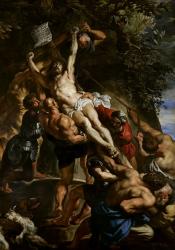The Elevation of the Cross
The artistic principles established in Renaissance art helped to guide artists for centuries after. The renaissance introduced the idea of secular subject matter, a focus on naturalism, and the representation of emotion in subjects. The baroque period that directly followed the Renaissance used these principles and pushed them even further. These artists focused on using vibrant colors and extreme lights and darks to create dramatic and dynamic works of art. The baroque artists rejected the tranquil expressions found in renaissance art and instead chose to imbue as much emotion in their subjects as possible. In this way the movement, emotion, and extravagance that characterizes baroque art sets it apart from the comparatively simple Renaissance art. The Elevation of the Cross by Peter Paul Rubens is an excellent example of how Baroque art differs from Renaissance art. Every panel of this triptych is packed with action, with the diagonal composition ultimately drawing the viewers eye to the drama of Christ on the cross being hoisted up. This piece evokes a visceral reaction in the viewer by taking the emotional principles established in the Renaissance and pushing them to the extreme.
Sources
Camara, Esperanca. “Baroque Art in Europe, an Introduction.” Khan Academy, 2018,
www.khanacademy.org/humanities/monarchy-enlightenment/baroque-art1/beginners-gui
de-baroque1/a/baroque-art-in-europe-an-introduction.
Stokstad, Marilyn, and Michael W. Cothren. Art History. Upper Saddle River, NJ:
Pearson/Prentice Hall, 2011. Print.
Image Retrieved from Wikimedia Commons, fair use

